Abstract
1 The effects of 5 mg/kg acebutolol given intravenously were investigated in anaesthetized dogs after (a) ligation of the left anterior descending coronary artery and (b) coronary reperfusion following 60 min of ligation of the anterior descending coronary artery. 2 Coronary artery ligation produced, after 4 to 6 h, persistent multiple ventricular ectopic beats and abnormalities of R and T waves and of the S-T segment. Administration of acebutolol, after the development of persistent ventricular arrhythmias, restored normal sinus rhythm within 5 min of injection. Electrocardiographic abnormalities were also reduced. 3 Coronary artery reperfusion (following 60 min of ligation) resulted in multiple ventricular ectopic beats, ventricular tachycardia and/or ventricular fibrillation. Pretreatment with acebutolol, 15 min before starting reperfusion, markedly reduced the arrhythmias. 4 Acebutolol did not affect peak inspiratory airway pressure. 5 Acebutolol produced significant bradycardia and slight, transient, hypotension. It was without effect on left ventricular systolic pressure, left ventricular end-diastolic pressure, cardiac output or pulmonary arterial pressure. 6 These results suggest beneficial effects of acebutolol in myocardial ischaemia and coronary reperfusion, without any significant risk of cardiodepression or bronchospasm.
Full text
PDF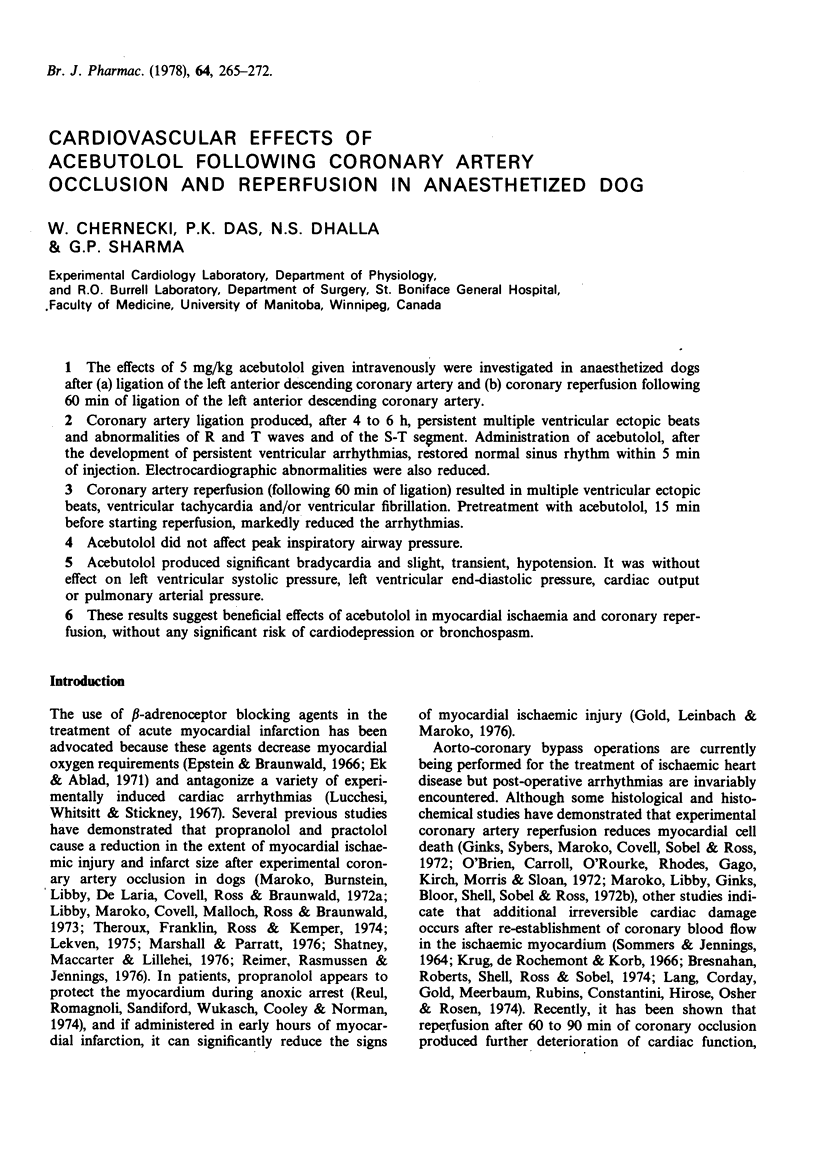
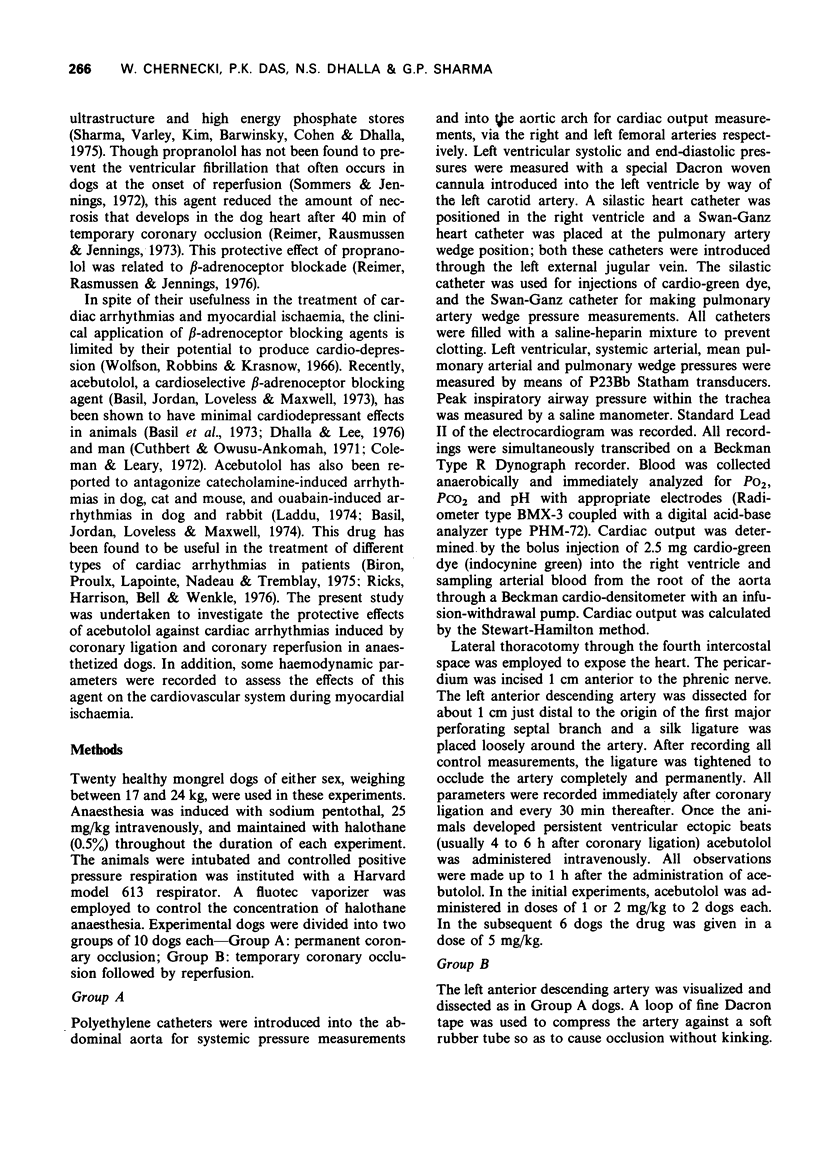
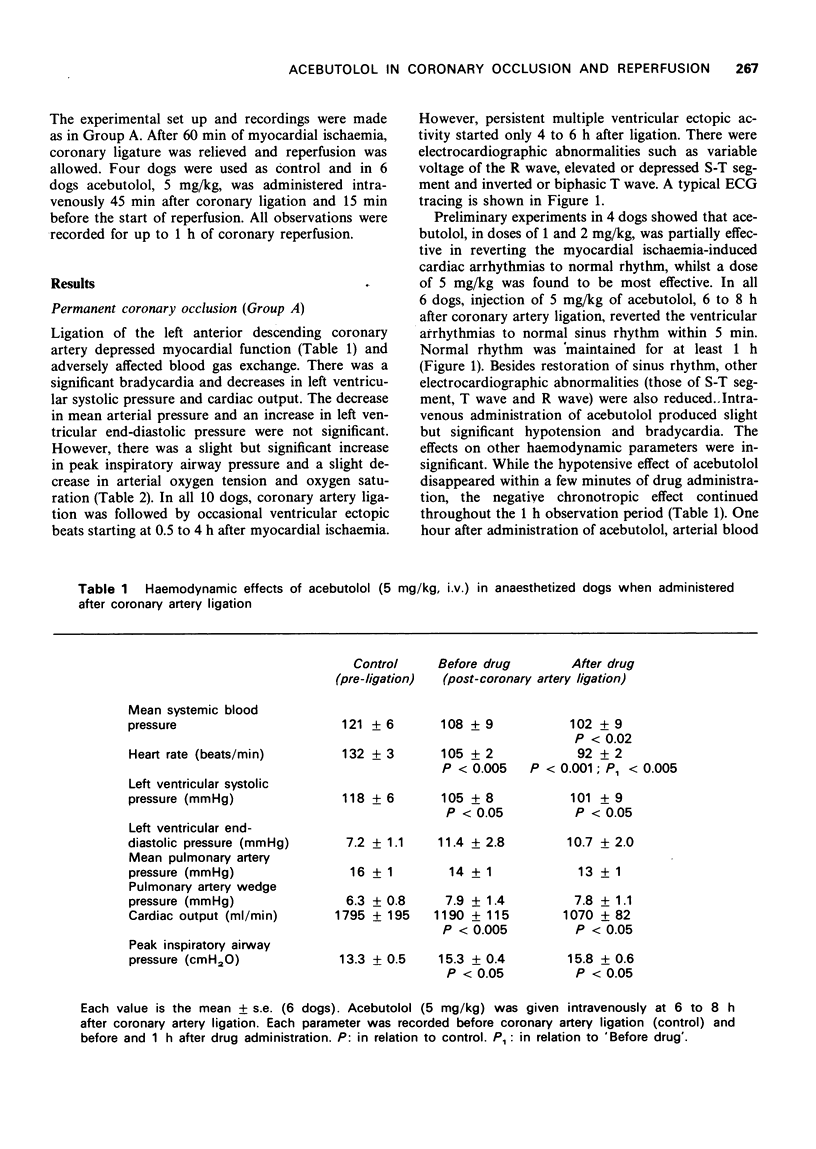
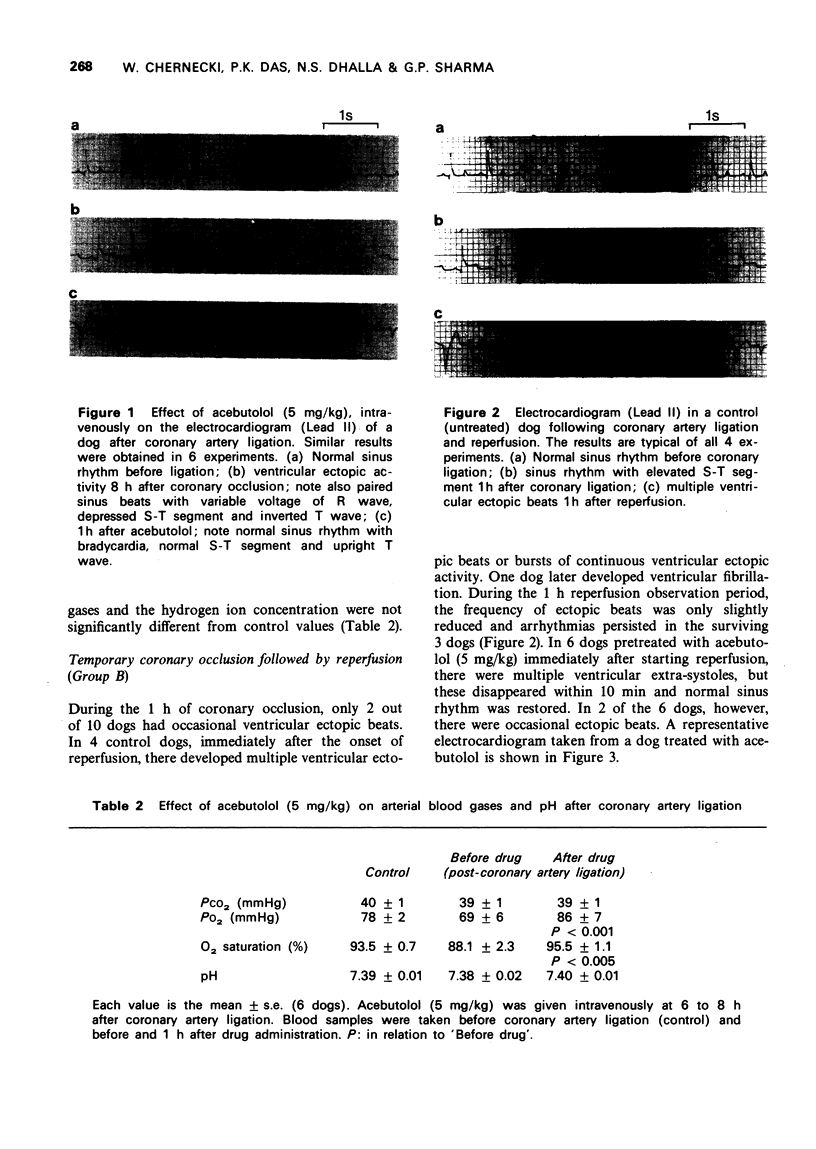
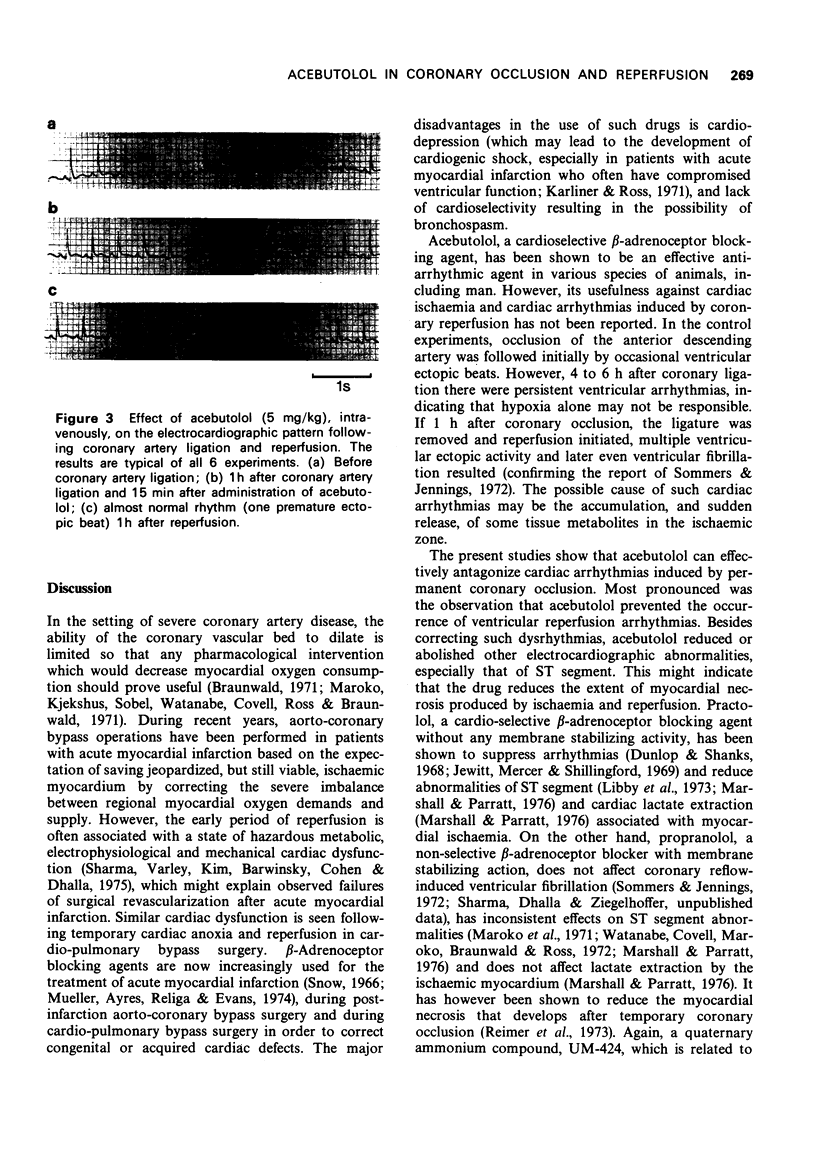
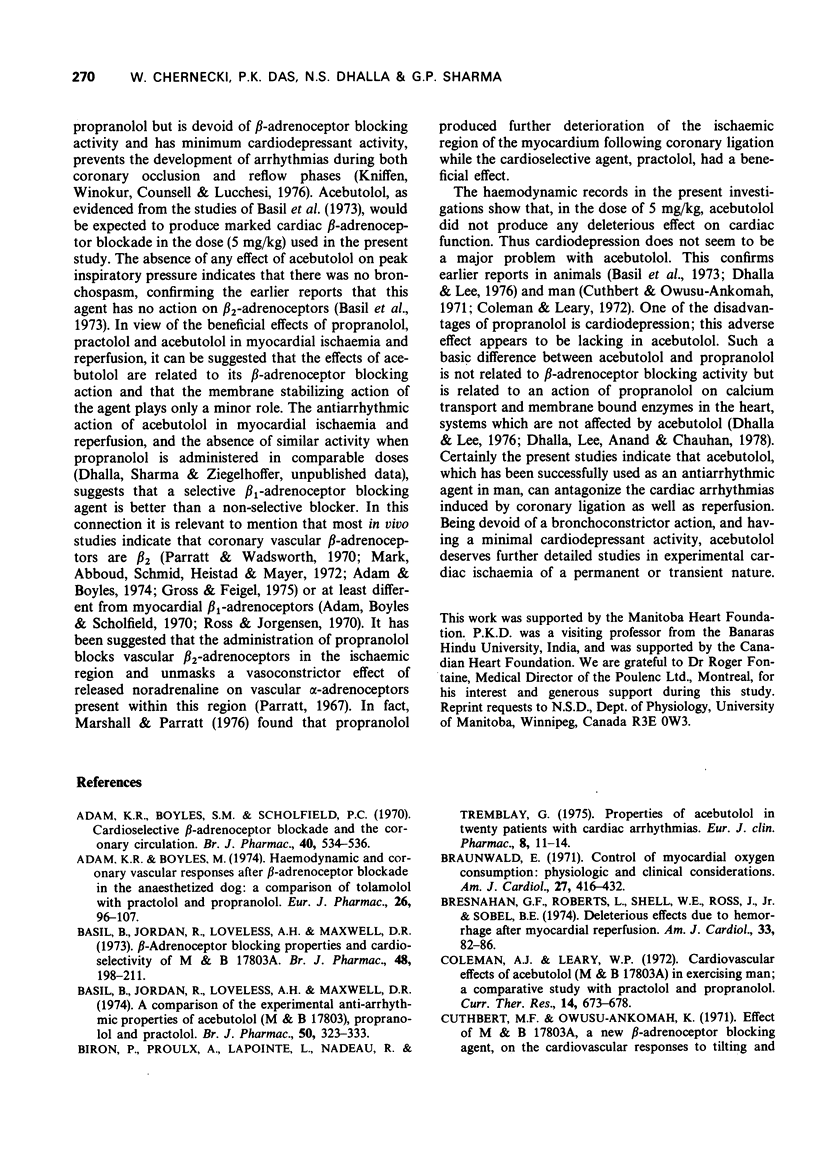
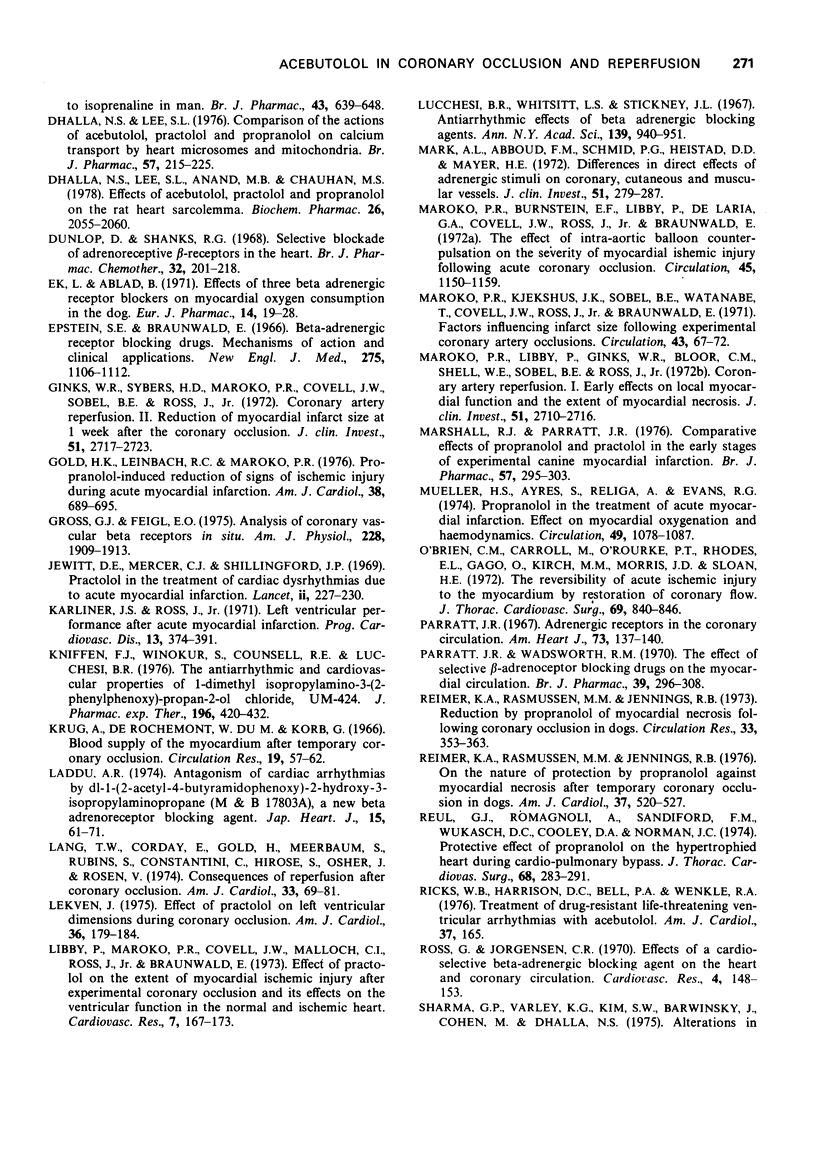
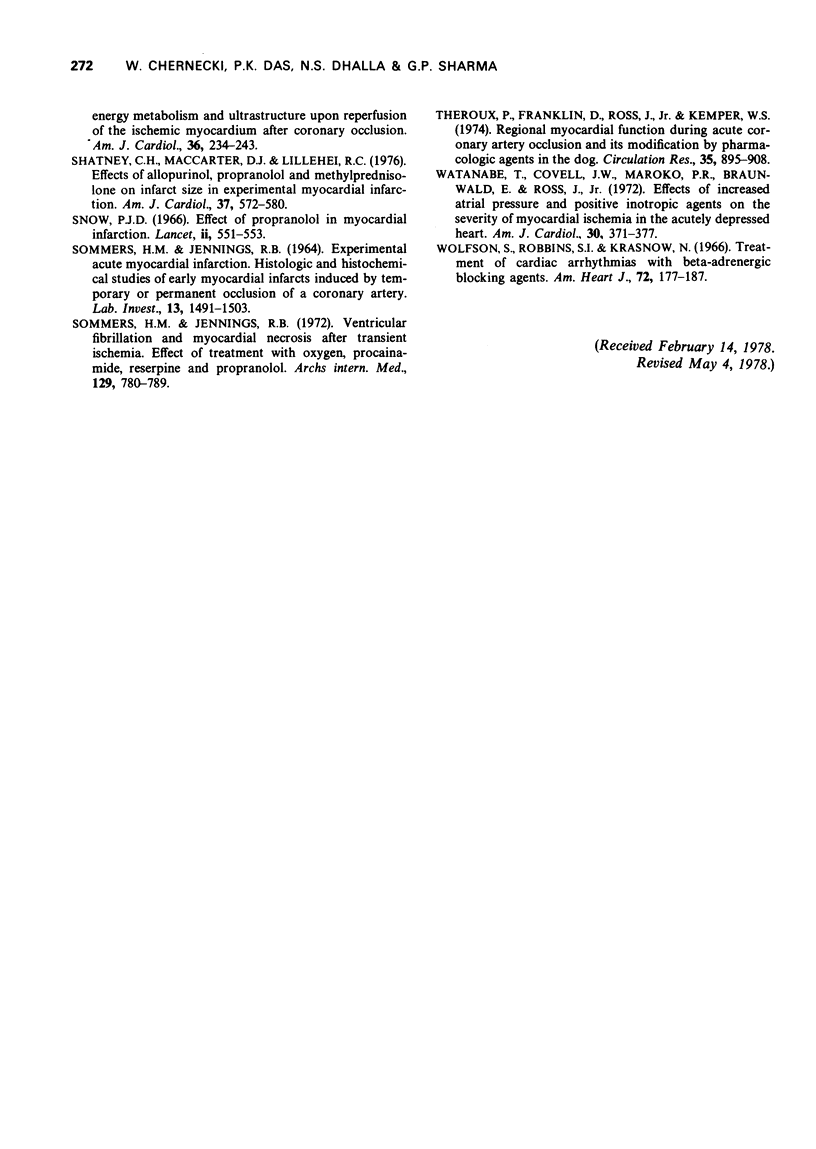
Images in this article
Selected References
These references are in PubMed. This may not be the complete list of references from this article.
- Adam K. R., Boyles S. M. Haemodynamic and coronary vascular responses after beta-adrenoceptor blockade in the anaesthetised dog: a comparison of tolamolol with practolol and propranolol. Eur J Pharmacol. 1974 Apr;26(1):96–107. doi: 10.1016/0014-2999(74)90079-x. [DOI] [PubMed] [Google Scholar]
- Adam K. R., Boyles S., Scholfield P. C. Cardio-selective beta-adrenoceptor blockade and the coronary circulation. Br J Pharmacol. 1970 Nov;40(3):534–536. doi: 10.1111/j.1476-5381.1970.tb10639.x. [DOI] [PMC free article] [PubMed] [Google Scholar]
- Basil B., Jordan R., Loveless A. H., Maxwell D. R. A comparison of the experimental anti-arrhythmic properties of acebutolol (M and B 17,803), propranolol and practolol. Br J Pharmacol. 1974 Mar;50(3):323–333. doi: 10.1111/j.1476-5381.1974.tb09607.x. [DOI] [PMC free article] [PubMed] [Google Scholar]
- Basil B., Jordan R., Loveless A. H., Maxwell D. R. Beta-adrenoceptor blocking properties and cardioselectivity of M & B 17,803A. Br J Pharmacol. 1973 Jun;48(2):198–211. doi: 10.1111/j.1476-5381.1973.tb06906.x. [DOI] [PMC free article] [PubMed] [Google Scholar]
- Biron P., Proulx A., Lapointe L., Nadeau R., Tremblay G. Properties of acebutolol in twenty patients with cardiac arrhythmias. Eur J Clin Pharmacol. 1975;8(1):11–14. doi: 10.1007/BF00616409. [DOI] [PubMed] [Google Scholar]
- Braunwald E. Control of myocardial oxygen consumption: physiologic and clinical considerations. Am J Cardiol. 1971 Apr;27(4):416–432. doi: 10.1016/0002-9149(71)90439-5. [DOI] [PubMed] [Google Scholar]
- Bresnahan G. F., Roberts R., Shell W. E., Ross J., Jr, Sobel B. E. Deleterious effects due to hemorrhage after myocardial reperfusion. Am J Cardiol. 1974 Jan;33(1):82–86. doi: 10.1016/0002-9149(74)90742-5. [DOI] [PubMed] [Google Scholar]
- Coleman A. J., Leary W. P. Cardiovascular effects of acebutolol (M & B 17803A), in exercising man; a comparative study with practolol and propranolol. Curr Ther Res Clin Exp. 1972 Oct;14(10):673–678. [PubMed] [Google Scholar]
- Cuthbert M. F., Owusu-Ankomah K. Effect of M & B 17803A, a new -adrenoceptor blocking agent, on the cardiovascular responses to tilting and to isoprenaline in man. Br J Pharmacol. 1971 Nov;43(3):639–648. doi: 10.1111/j.1476-5381.1971.tb07193.x. [DOI] [PMC free article] [PubMed] [Google Scholar]
- Dhalla N. S., Lee S. L., Anand M. B., Chauhan M. S. Effects of acebutolol, practolol and propranolol on the rat heart sarcolemma. Biochem Pharmacol. 1977 Nov 1;26(21):2055–2060. doi: 10.1016/0006-2952(77)90016-8. [DOI] [PubMed] [Google Scholar]
- Dhalla N. S., Lee S. L. Comparison of the actions of acebutolol, practolol and propranolol on calcium transport by heart microsomes and mitochondria. Br J Pharmacol. 1976 Jun;57(2):215–221. doi: 10.1111/j.1476-5381.1976.tb07470.x. [DOI] [PMC free article] [PubMed] [Google Scholar]
- Dunlop D., Shanks R. G. Selective blockade of adrenoceptive beta receptors in the heart. Br J Pharmacol Chemother. 1968 Jan;32(1):201–218. doi: 10.1111/j.1476-5381.1968.tb00444.x. [DOI] [PMC free article] [PubMed] [Google Scholar]
- Ek L., Ablad B. Effects of three beta adrenergic receptor blockers on myocardial oxygen consumption in the dog. Eur J Pharmacol. 1971;14(1):19–28. doi: 10.1016/0014-2999(71)90118-x. [DOI] [PubMed] [Google Scholar]
- Epstein S. E., Braunwald E. Beta-adrenergic receptor blocking drugs. Mechanisms of action and clinical applications. N Engl J Med. 1966 Nov 17;275(20):1106–contd. doi: 10.1056/NEJM196611172752006. [DOI] [PubMed] [Google Scholar]
- Ginks W. R., Sybers H. D., Maroko P. R., Covell J. W., Sobel B. E., Ross J., Jr Coronary artery reperfusion. II. Reduction of myocardial infarct size at 1 week after the coronary occlusion. J Clin Invest. 1972 Oct;51(10):2717–2723. doi: 10.1172/JCI107091. [DOI] [PMC free article] [PubMed] [Google Scholar]
- Gold H. K., Leinbach R. C., Maroko P. R. Propranolol-induced reduction of signs of ischemic injury during acute myocardial infarction. Am J Cardiol. 1976 Nov 23;38(6):689–695. doi: 10.1016/0002-9149(76)90344-1. [DOI] [PubMed] [Google Scholar]
- Gross G. J., Feigl E. O. Analysis of coronary vascular beta receptors in situ. Am J Physiol. 1975 Jun;228(6):1909–1913. doi: 10.1152/ajplegacy.1975.228.6.1909. [DOI] [PubMed] [Google Scholar]
- Jewitt D. E., Mercer C. J., Shillingford J. P. Practolol in the treatment of cardiac dysrhythmias due to acute myocardial infarction. Lancet. 1969 Aug 2;2(7614):227–230. doi: 10.1016/s0140-6736(69)90001-4. [DOI] [PubMed] [Google Scholar]
- Karliner J. S., Ross J., Jr Left ventricular performance after acute myocardial infarction. Prog Cardiovasc Dis. 1971 Jan;13(4):374–391. doi: 10.1016/s0033-0620(71)80013-0. [DOI] [PubMed] [Google Scholar]
- Kniffen F. J., Winokur S., Counsell R. E., Lucchesi B. R. The antiarrhythmic and cardiovascular properties of 1-dimethyl isopropylamino-3-(2-phenylphenoxy)-propan-2-ol chloride, UM-424. J Pharmacol Exp Ther. 1976 Feb;196(2):420–432. [PubMed] [Google Scholar]
- Krug A., Du Mesnil de Rochemont, Korb G. Blood supply of the myocardium after temporary coronary occlusion. Circ Res. 1966 Jul;19(1):57–62. doi: 10.1161/01.res.19.1.57. [DOI] [PubMed] [Google Scholar]
- Laddu A. R. Antagonism of cardiac arrhythmias by dl-1-(2-acetyl-4-butyramidophenoxy)-2-hydroxy-3-isopropylaminopropane (M & B 17,803A), a new beta adrenoreceptor blocking agent. Jpn Heart J. 1974 Jan;15(1):61–71. doi: 10.1536/ihj.15.61. [DOI] [PubMed] [Google Scholar]
- Lang T. W., Corday E., Gold H., Meerbaum S., Rubins S., Costantini C., Hirose S., Osher J., Rosen V. Consequences of reperfusion after coronary occlusion. Effects on hemodynamic and regional myocardial metabolic function. Am J Cardiol. 1974 Jan;33(1):69–81. doi: 10.1016/0002-9149(74)90741-3. [DOI] [PubMed] [Google Scholar]
- Lekven J. Effect of practolol on left ventricular dimensions during coronary occlusion. Am J Cardiol. 1975 Aug;36(2):179–184. doi: 10.1016/0002-9149(75)90523-8. [DOI] [PubMed] [Google Scholar]
- Libby P., Maroko P. R., Covell J. W., Malloch C. I., Ross J., Jr, Braunwald E. Effect of practolol on the extent of myocardial ischaemic injury after experimental coronary occlusion and its effects of ventricular function in the normal and ischaemic heart. Cardiovasc Res. 1973 Mar;7(2):167–173. doi: 10.1093/cvr/7.2.167. [DOI] [PubMed] [Google Scholar]
- Lucchesi B. R., Whitsitt L. S., Stickney J. L. Antiarrhythmic effects of beta adrenergic blocking agents. Ann N Y Acad Sci. 1967 Feb 10;139(3):940–951. doi: 10.1111/j.1749-6632.1967.tb41262.x. [DOI] [PubMed] [Google Scholar]
- Mark A. L., Abboud F. M., Schmid P. G., Heistad D. D., Mayer H. E. Differences in direct effects of adrenergic stimuli on coronary, cutaneous, and muscular vessels. J Clin Invest. 1972 Feb;51(2):279–287. doi: 10.1172/JCI106812. [DOI] [PMC free article] [PubMed] [Google Scholar]
- Maroko P. R., Bernstein E. F., Libby P., DeLaria G. A., Covell J. W., Ross J., Jr, Braunwald E. Effects of intraaortic balloon counterpulsation on the severity of myocardial ischemic injury following acute coronary occlusion. Counterpulsation and myocardial injury. Circulation. 1972 Jun;45(6):1150–1159. doi: 10.1161/01.cir.45.6.1150. [DOI] [PubMed] [Google Scholar]
- Maroko P. R., Kjekshus J. K., Sobel B. E., Watanabe T., Covell J. W., Ross J., Jr, Braunwald E. Factors influencing infarct size following experimental coronary artery occlusions. Circulation. 1971 Jan;43(1):67–82. doi: 10.1161/01.cir.43.1.67. [DOI] [PubMed] [Google Scholar]
- Maroko P. R., Libby P., Ginks W. R., Bloor C. M., Shell W. E., Sobel B. E., Ross J., Jr Coronary artery reperfusion. I. Early effects on local myocardial function and the extent of myocardial necrosis. J Clin Invest. 1972 Oct;51(10):2710–2716. doi: 10.1172/JCI107090. [DOI] [PMC free article] [PubMed] [Google Scholar]
- Marshall R. J., Parratt J. R. Comparative effects of propranolol and practolol in the early stages of experimental canine myocardial infarction. Br J Pharmacol. 1976 Jun;57(2):295–303. doi: 10.1111/j.1476-5381.1976.tb07479.x. [DOI] [PMC free article] [PubMed] [Google Scholar]
- Mueller H. S., Ayres S. M., Religa A., Evans R. G. Propranolol in the treatment of acute myocardial infarction. Effect on myocardial oxygenation and hemodynamics. Circulation. 1974 Jun;49(6):1078–1087. doi: 10.1161/01.cir.49.6.1078. [DOI] [PubMed] [Google Scholar]
- O'Brien C. M., Carroll M., O'Rourke P. T., Rhodes E. L., Gago O., Kirsh M. M., Morris J. D., Sloan H. E. The reversibility of acute ischemic injury to the myocardium by restoration of coronary flow. J Thorac Cardiovasc Surg. 1972 Dec;64(6):840–846. [PubMed] [Google Scholar]
- Parratt J. R. Adrenergic receptors in the coronary circulation. Am Heart J. 1967 Jan;73(1):137–140. doi: 10.1016/0002-8703(67)90321-3. [DOI] [PubMed] [Google Scholar]
- Parratt J. R., Wadsworth R. M. The effect of "selective" beta-adrenoceptor blocking drugs on the myocardial circulation. Br J Pharmacol. 1970 Jun;39(2):296–308. doi: 10.1111/j.1476-5381.1970.tb12893.x. [DOI] [PMC free article] [PubMed] [Google Scholar]
- Puri P. S., Varley K. G., Kim S. W., Barwinsky J., Cohen M., Dhalla N. S. Alterations in energy metabolism and ultrastructure upon reperfusion of the ischemic myocardium after coronary occlusion. Am J Cardiol. 1975 Aug;36(2):234–243. [PubMed] [Google Scholar]
- Reimer K. A., Rasmussen M. M., Jennings R. B. On the nature of protection by propranolol against myocardial necrosis after temporary coronary occlusion in dogs. Am J Cardiol. 1976 Mar 31;37(4):520–527. doi: 10.1016/0002-9149(76)90391-x. [DOI] [PubMed] [Google Scholar]
- Reimer K. A., Rasmussen M. M., Jennings R. B. Reduction by propranolol of myocardial necrosis following temporary coronary artery occlusion in dogs. Circ Res. 1973 Sep;33(3):353–363. doi: 10.1161/01.res.33.3.353. [DOI] [PubMed] [Google Scholar]
- Reul G. J., Jr, Romagnoli A., Sandiford F. M., Wukasch D. C., Cooley D. A., Norman J. C. Protective effect of propranolol on the hypertrophied heart during cardiopulmonary bypass. J Thorac Cardiovasc Surg. 1974 Aug;68(2):283–291. [PubMed] [Google Scholar]
- Ross G., Jorgensen C. R. Effects of a cardio-selective beta-adrenergic blocking agent on the heart and coronary circulation. Cardiovasc Res. 1970 Apr;4(2):148–153. doi: 10.1093/cvr/4.2.148. [DOI] [PubMed] [Google Scholar]
- SOMMERS H. M., JENNINGS R. B. EXPERIMENTAL ACUTE MYOCARDIAL INFARCTION; HISTOLOGIC AND HISTOCHEMICAL STUDIES OF EARLY MYOCARDIAL INFARCTS INDUCED BY TEMPORARY OR PERMANENT OCCLUSION OF A CORONARY ARTERY. Lab Invest. 1964 Dec;13:1491–1503. [PubMed] [Google Scholar]
- Shatney C. H., MacCarter D. J., Lillehei R. C. Effects of allopurinol, propranolol and methylprednisolone on infarct size in experimental myocardial infarction. Am J Cardiol. 1976 Mar 31;37(4):572–580. doi: 10.1016/0002-9149(76)90398-2. [DOI] [PubMed] [Google Scholar]
- Sommers H. M., Jennings R. B. Ventricular fibrillation and myocardial necrosis after transient ischemia. Effect of treatment with oxygen, procainamide, reserpine, and propranolol. Arch Intern Med. 1972 May;129(5):780–789. [PubMed] [Google Scholar]
- Theroux P., Franklin D., Ross J., Jr, Kemper W. S. Regional myocardial function during acute coronary artery occlusion and its modification by pharmacologic agents in the dog. Circ Res. 1974 Dec;35(6):896–908. doi: 10.1161/01.res.35.6.896. [DOI] [PubMed] [Google Scholar]
- Watanabe T., Covell J. W., Maroko P. R., Braunwald E., Ross J., Jr Effects of increased arterial pressure and positive inotropic agents on the severity of myocardial ischemia in the acutely depressed heart. Am J Cardiol. 1972 Sep;30(4):371–377. doi: 10.1016/0002-9149(72)90567-x. [DOI] [PubMed] [Google Scholar]
- Wolfson S., Robbins S. I., Krasnow N. Treatment of cardiac arrhythmias with beta-adrenergic blocking agents. Clinical and experimental studies. Am Heart J. 1966 Aug;72(2):176–187. doi: 10.1016/0002-8703(66)90441-8. [DOI] [PubMed] [Google Scholar]





